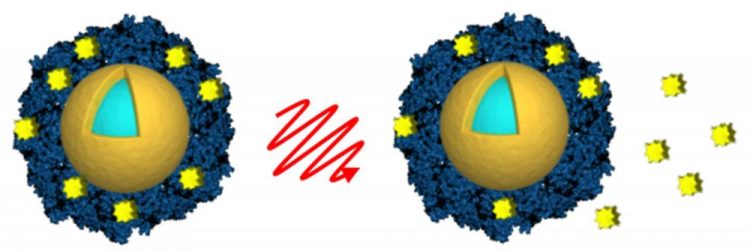Nanoshells could deliver more chemo with fewer side effects

Researchers from Rice University and Northwestern University loaded light-activated nanoshells (gold and light blue) with the anticancer drug lapatinib (yellow) by encasing the drug in an envelope of albumin (blue). Light from a near-infrared laser (center) was used to remotely trigger the release of the drug (right) after the nanoshells were taken up by cancer cells. Credit: A. Goodman/Rice University Usage Restrictions: For news reporting purposes only.
Researchers investigating ways to deliver high doses of cancer-killing drugs inside tumors have shown they can use a laser and light-activated gold nanoparticles to remotely trigger the release of approved cancer drugs inside cancer cells in laboratory cultures.
The study by researchers at Rice University and Northwestern University Feinberg School of Medicine appears in this week's online Early Edition of the Proceedings of the National Academy of Sciences. It employed gold nanoshells to deliver toxic doses of two drugs — lapatinib and docetaxel — inside breast cancer cells. The researchers showed they could use a laser to remotely trigger the particles to release the drugs after they entered the cells.
Though the tests were conducted with cell cultures in a lab, the research was designed to demonstrate clinical applicability: The nanoparticles are nontoxic, the drugs are widely used and the low-power, infrared laser can noninvasively shine through tissue and reach tumors several inches below the skin.
“In future studies, we plan to use a Trojan-horse strategy to get the drug-laden nanoshells inside tumors,” said Naomi Halas, an engineer, chemist and physicist at Rice University who invented gold nanoshells and has spent more than 15 years researching their anticancer potential. “Macrophages, a type of white blood cell that's been shown to penetrate tumors, will carry the drug-particle complexes into tumors, and once there we use a laser to release the drugs.”
Co-author Susan Clare, a research associate professor of surgery at the Northwestern University Feinberg School of Medicine, said the PNAS study was designed to demonstrate the feasibility of the Trojan-horse approach. In addition to demonstrating that drugs could be released inside cancer cells, the study also showed that in macrophages, the drugs did not detach prior to triggering.
“Getting chemotherapeutic drugs to penetrate tumors is very challenging,” said Clare, also a Northwestern Medicine breast cancer surgeon. “Drugs tend to get pushed out of tumors rather than drawn in. To get an effective dose at the tumor, patients often have to take so much of the drug that nausea and other side effects become severe. Our hope is that the combination of macrophages and triggered drug-release will boost the effective dose of drugs within tumors so that patients can take less rather than more.”
If the approach works, Clare said, it could result in fewer side effects and potentially be used to treat many kinds of cancer. For example, one of the drugs in the study, lapatinib, is part of a broad class of chemotherapies called tyrosine kinase inhibitors that target specific proteins linked to different types of cancer. Other Federal Drug Administration-approved drugs in the class include imatinib (leukemia), gefitinib (breast, lung), erlotinib (lung, pancreatic), sunitinib (stomach, kidney) and sorafenib (liver, thyroid and kidney).
“All the tyrosine kinase inhibitors are notoriously insoluble in water,” said Amanda Goodman, a Rice alumna and lead author of the PNAS study. “As a drug class, they have poor bioavailability, which means that a relatively small proportion of the drug in each pill is actually killing cancer cells. If our method works for lapatinib and breast cancer, it may also work for the other drugs in the class.”
Halas invented nanoshells at Rice in the 1990s. About 20 times smaller than a red blood cell, they are made of a sphere of glass covered by a thin layer of gold. Nanoshells can be tuned to capture energy from specific wavelengths of light, including near-infrared (near-IR), a nonvisible wavelength that passes through most tissues in the body. Nanospectra Biosciences, a licensee of this technology, has performed several clinical trials over the past decade using nanoshells as photothermal agents that destroy tumors with infrared light.
Clare and Halas' collaboration on nanoshell-based drug delivery began more than 10 years ago. In earlier work, they showed that a near-IR continuous-wave laser — the same kind that produces heat in the photothermal applications of nanoshells — could be used to trigger the release of drugs from nanoshells.
In the latest study, Goodman contrasted the use of continuous-wave laser triggering and triggering with a low-power pulse laser. Using each type of laser, she demonstrated the remotely triggered release of drugs from two types of nanoshell-drug conjugates. One type used a DNA linker and the drug docetaxel, and the other employed a coating of the blood protein albumin to trap and hold lapatinib. In each case, Goodman found she could trigger the release of the drug after the nanoshells were taken up inside cancer cells. She also found no measureable premature release of drugs in macrophages in either case.
Halas and Clare said they hope to begin animal tests of the technology soon and have an established mouse model that could be used for the testing.
“I'm particularly excited about the potential for lapatinib,” Clare said. “The first time I heard about Naomi's work, I wondered if it might be the answer to delivering drugs into the anoxic (depleted of oxygen) interior of tumors where some of the most aggressive cancer cells lurk. As clinicians, we're always looking for ways to keep cancer from coming back months or years later, and I am hopeful this can do that.”
###
Additional co-authors include Oara Neumann and Luke Henderson, both of Rice, Mi-Ran Choi of Northwestern and Kamilla Nørregaard of the University of Copenhagen. The research was supported by the Department of Defense Breast Cancer Research Program, the Welch Foundation and the National Science Foundation.
The DOI of the PNAS paper is: 10.1073/pnas.1713137114
A copy of the paper is available at: http://www.
Related research from Rice:
Freshwater from salt water using only solar energy — June 19, 2017 http://news.
Rice lab expands palette for color-changing glass — March 8, 2017 http://news.
Rice's 'antenna-reactor' catalysts offer best of both worlds — July 18, 2016 http://news.
Rice experts unveil submicroscopic tunable, optical amplifier — May 9, 2016 http://news.
Nanoscale drawbridges open path to color displays — Dec. 4, 2015 http://news.
Rice finding could lead to cheap, efficient metal-based solar cells — July 22, 2015 http://news.
This release can be found online at news.rice.edu.
Follow Rice News and Media Relations on Twitter @RiceUNews
Located on a 300-acre forested campus in Houston, Rice University is consistently ranked among the nation's top 20 universities by U.S. News & World Report. Rice has highly respected schools of Architecture, Business, Continuing Studies, Engineering, Humanities, Music, Natural Sciences and Social Sciences and is home to the Baker Institute for Public Policy. With 3,879 undergraduates and 2,861 graduate students, Rice's undergraduate student-to-faculty ratio is 6-to-1. Its residential college system builds close-knit communities and lifelong friendships, just one reason why Rice is ranked No. 1 for quality of life and for lots of race/class interaction and No. 2 for happiest students by the Princeton Review. Rice is also rated as a best value among private universities by Kiplinger's Personal Finance. To read “What they're saying about Rice,” go to http://tinyurl.
Media Contact
All latest news from the category: Health and Medicine
This subject area encompasses research and studies in the field of human medicine.
Among the wide-ranging list of topics covered here are anesthesiology, anatomy, surgery, human genetics, hygiene and environmental medicine, internal medicine, neurology, pharmacology, physiology, urology and dental medicine.
Newest articles

Security vulnerability in browser interface
… allows computer access via graphics card. Researchers at Graz University of Technology were successful with three different side-channel attacks on graphics cards via the WebGPU browser interface. The attacks…

A closer look at mechanochemistry
Ferdi Schüth and his team at the Max Planck Institut für Kohlenforschung in Mülheim/Germany have been studying the phenomena of mechanochemistry for several years. But what actually happens at the…

Severe Vulnerabilities Discovered in Software to Protect Internet Routing
A research team from the National Research Center for Applied Cybersecurity ATHENE led by Prof. Dr. Haya Schulmann has uncovered 18 vulnerabilities in crucial software components of Resource Public Key…





















